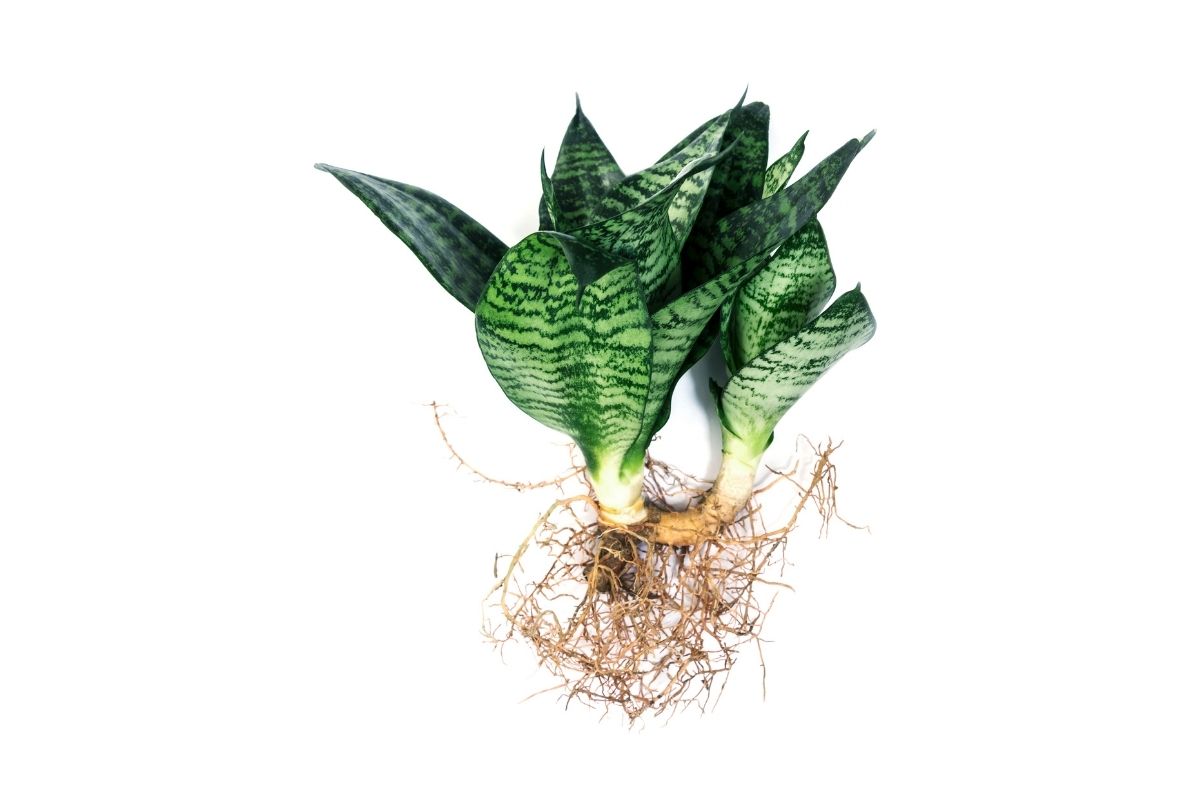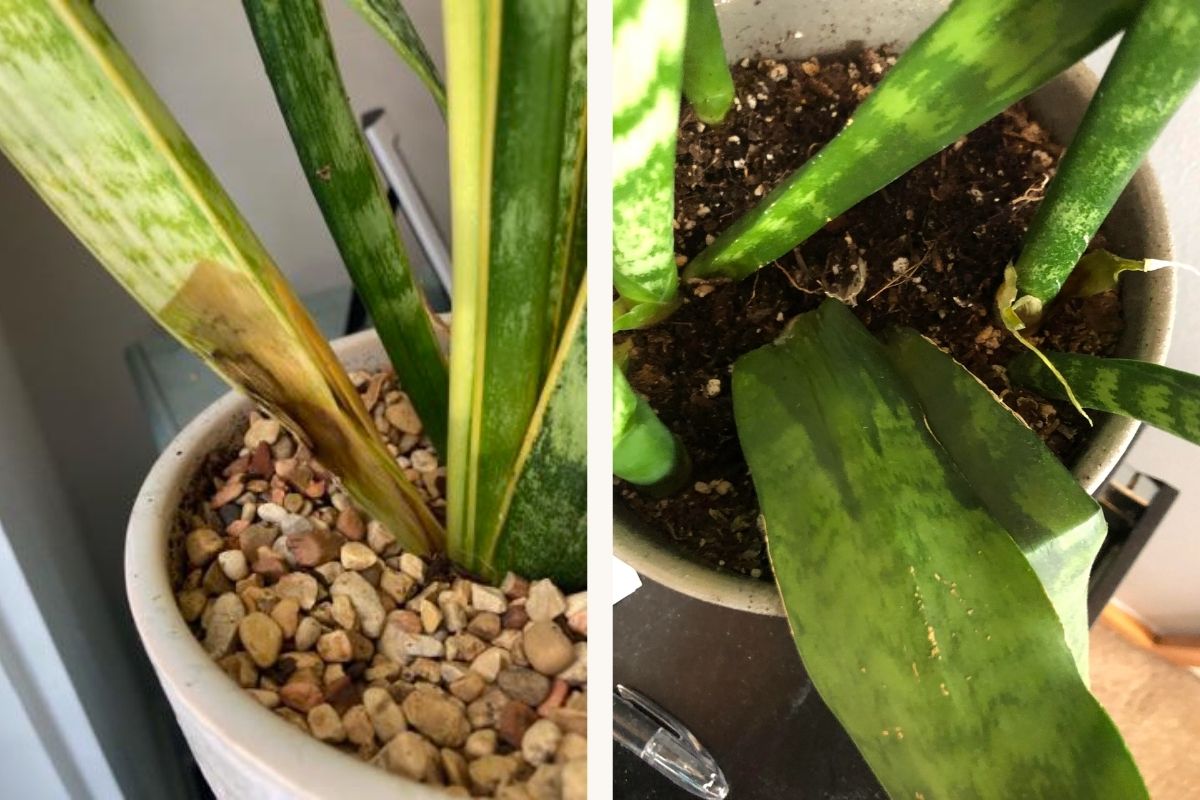Key takeaways:
- Snake plants are hardy, drought-tolerant plants, and they need less water than you may think.
- Soft, mushy, drooping, yellowing leaves are signs of an overwatered snake plant.
- To revive an overwatered snake plant, repot in well-draining soil and trim away dead roots and leaves.
Snake plants are some of the most popular houseplants available. You’ll hear them called a number of names, like mother-in-law’s tongue, Saint George’s sword, and viper’s bowstring hemp. They’re hardy and they’re very attractive, in my biased opinion. And for the most part, snake plants are the easiest houseplants in the world to care for…
…unless you’re like me and find ways to screw even that up. You see, the snake plant’s roots are very sensitive to overly wet soil, and overall soil moisture.
Overwatering snake plants can lead to root rot if you don’t catch the warning signs early. Snake plants are somewhat prone to root rot, you see.
That’s what happened to my snake plant – but at the time I didn’t know what was happening to my sweet plant!
This article is going to help you identify issues with overwatering, and what you can do to save your plant, and keep its root system healthy.
Signs of an overwatered snake plant
Overwatering a snake plant is an easy mistake to make.
In fact, you can possibly overwater it without ever watering it at all!
I had my snake plant just outside my front door in this cute little shaded patio that is the perfect spot for all of our houseplants. Except that I live in a tropical climate and this year is especially rainy, so my snake plant was experiencing root rot although I never actually water it.
If you’re not in a tropical climate during monsoon season, then regular watering might get you the same results.
They are hardy, drought-tolerant plants, and they need less water than you may think. When you give your snake plant too much water, you’ll find that the roots start to become saturated and waterlogged.
Waterlogged roots lead to rotting roots, and that’s something you’ll want to avoid if you ever want to see new growth in your snake plant ever again.
However, signs aren’t seen in the root ball and soggy soil alone. You can also identify issues with overwatering by looking at snake plant leaves. Snake plants are known for having tall, rigid leaves. A healthy snake plant sometimes seems artificial thanks to how sturdy the leaves are! (My partner once watered a fake snake plant for a few months before realizing that it was fake hehe they’re remarkably rubbery)
If you’re worried about overwatering, then review the signs below. If these seem to describe your plant, then you may have an overwatered snake plant.
- Drooping leaves. One of the first signs of overwatering that you’ll see is droopy snake plant leaves, depending on where the excess water accumulates. Leaves start to become heavy, squishy, and limp, causing them to fall over.
- Snake plant leaf filled with water. Excess water in the leaves causes the cellular structure of the leaves to break down, making them soft, and sometimes even mushy.
- Snake plant leaves turning soft. Overwatered snake plants will have squishy leaves that are soft to the touch. You may see this sign before the leaves start to droop.
- Smelly soil. Root rot is one of the biggest concerns associated with snake plants. When there’s an abundance of water in your snake plant’s soil, fungi and bacteria can grow, and they’ll eat away the roots of your plant. As they do, the wet soil starts to smell like rot. 🤢
- Falling over. Snake plants are known for their ability to stand upright. When you’ve overwatered your snake plant, sometimes the entire plant will start to “fall over.” This is when all of the leaves on the plant begin to droop, like the plant is tipping to one direction.
- Yellowing leaves. Yellow leaves are a common symptom of many plant ailments. In snake plants, an overwatered plant’s leaves turn yellow. Snake plants are supposed to have dark green leaves that are sometimes patterned.
For the most part, you’ll know root rot in snake plants when you see it. Just like you know when a veggie has passed its I’m-willing-to-eat-this-date in the fridge, you’ll recognize the mushy, stinky signs of root rot on your snake plant.
Sometimes, though, it’s not all that obvious. This Redditor swears their plant is suffering from root rot and is asking for help from other plant enthusiasts.
Either way, it’s worth repotting the plant in dry cactus soil to give it a chance to recover from any potential root rot.
How to save an overwatered snake plant
If your snake plant is starting to show signs of excess moisture and overwatering, it can be saved if it’s caught early enough. Take a look at our thorough instructions on how to save your snake plant from overwatering.
What you’ll need
- A new pot with good drainage holes (I’m obsessed with this one)
- Fresh cactus soil or potting mix
- Clippers or scissors
- Time, normally a few days
Step 1: Move your snake plant to a sunny spot
If you’re trying to save your snake plant from overwatering, the first thing you have to do is move your plant to a sunny spot. Direct sunlight is going to help with removing water from the soil. The plant will use the water faster, and excess water will evaporate over time.
To save an overwatered snake plant, you have to start with dry soil. If you pull an overwatered plant from wet soil, it’s going to be hard to assess the condition of the root ball directly. Soil needs to be completely dry to be able to look at the roots effectively. Let drying happen naturally. Never, ever use a drying medium to help your plant dry. Using something like a hair dryer on your snake plant is going to harm your plant more than help it.
Step 2: Remove your snake plant from the old soil
The next thing you need to do to begin saving your plant is remove it from its old pot and soil. When a plant is overwatered, there may be no visible damage to the foliage, but you have to be concerned about the state of the roots, as well as the soil that it has been sitting in.
When the potting medium becomes too saturated, you have to worry about a few things, the most important being disease. Snake plants are susceptible to fungal disease, as well as bacterial issues. To prevent fungal infection, you have to remove the soil that may be housing things that will eat away at your snake plant’s roots.
Step 3: Look for signs of root rot
After you’ve removed all of the soil from your snake plant’s root ball, you need to take a look at the roots a little more closely. When roots are submerged in too much water, they start to suffer from oxygen deprivation. When this happens, they start to die. If you’re caring for an overwatered snake plant, root rot is the number one thing you have to be worried about.
Snake plants have tubular roots, so they are normally thick and a creamy color. They have finer roots that reach out from there.
To save an overwatered snake plant, you’ll need to look for healthy roots. Any roots that seem to be suffering from root rot will need to be removed to prevent it from spreading.
With the roots exposed, it’s pretty easy to find root rot. Rotted roots are going to be brown, slimy, and will have a distinct smell. Prune your plant roots as far as need be.
Step 4: Repot your snake plant
Using your new pot and new potting medium, it’s time to repot your snake plant. Generally, snake plant potting soil should be loose soil, as this promotes adequate draining.
How to repot a snake plant
- First, gently remove the snake plant from its pot and brush away any soil.
- Prune the roots of the snake plant where there is dead tissue, taking care not to cut away more than 60% of the roots.
- Shake away the soil inside the root ball to find any hiding rotten roots. You can separate the pups at this point and give them their own pot if you’d like 🙂
- Fill your new pot 1/4 full with a mixture of cactus soil and the Fox Farm coco coir and perlite mixture (linked below).
- Place your snake plant in the pot and fill in the remaining space with your soil mixture.
- Pat the soil down and place the plant in a bright shaded spot. Let the soil dry out completely before watering again.
When planting, don’t water or apply snake plant fertilizer right away. If you give your plant any water after repotting, make it a very limited amount, and don’t water again until the soil dries completely.
Step 5: Knowing how much root rot is too much
A snake plant with badly rotted roots isn’t going to survive being repotted, unfortunately. Sometimes, overwatering can end up harming a plant faster than you’d think. As such, you may not be able to repot your snake plant to save it from overwatering.
All hope isn’t lost, though! You can save an overwatered snake plant through propagation.
When root rot is too much, find the healthiest leaves on your snake plant. These healthy leaves are going to be turned into cuttings. You’ll want to travel up the leaves, as far away from the roots as you can. This is going to help make sure that there’s no chance of the rot spreading.
Simply cut the snake plant leaves at a point where they seem healthiest. Then, lay the cuttings in sunlight for a few days, allowing the fresh cuts to “scab” up.
When the leaves have scabbed in the sun, you’re ready to plant them! Take care to plant cuttings in a new potting medium that won’t lead to overwatering issues, of course. They should be planted 1 to 2 inches deep, with the base under the soil and the foliage above it.
Water them very lightly and place their pot in indirect light. You should start to see new growth fairly quickly, since snake plants are so hardy. This is a great way to start a large number of your own plants, too.
Tips for avoiding snake plant overwatering

Like we’ve said before, snake plants are incredibly hardy plants. They can live through just about anything, and they are easy to propagate, which just shows how much they want to grow. Now, even though they’re very hardy, they are easy to overwater.
When you’re trying to avoid overwatering your snake plant, there are a number of ways to do so. You can keep a watering schedule, use various tools that can assist you, and use the right pot and potting medium. Check out some of the best tips to avoid overwatering below.
- Water consistently. The best way to avoid overwatering your snake plant is by watering it consistently but infrequently. (Read more: how often to water a snake plant) While it’s helpful to get on a watering schedule, it’s also helpful to just forget about it altogether. Stick your finger into the soil when it looks dry, or jab a moisture meter in for a deeper look. Water when it seems dry and maybe not even then. Honestly, they do just fine without water for a long while. Keep an eye on your plant’s condition, and look for signs of underwatering and overwatering.
- Make a good drainage system. Snake plants don’t need a lot of soil to be happy. Another way to avoid overwatering is by replacing extra soil at the bottom of the pot with a drainage medium. There’s a number of materials that can be used, and most of them are easy to find.
- Using a moisture meter. If you’re concerned about watering too much or too little, consider using a moisture meter. This is going to let you monitor your snake plant’s soil at all times, and help you avoid soggy conditions.
- Transplant your snake plant. If changing your watering schedule just hasn’t helped with the symptoms of overwatering, then an immediate transplant may be best. This gives you the opportunity to give your snake plant a fresh start, and lets you start things off right. Preserve the living roots before they have the chance to catch root rot.
- Change watering habits based on season. During the winter, snake plants need much less water. Often, they’ll only need to be watered once a month. If you see that your snake plant’s leaves are beginning to wrinkle, give them a light watering to keep them hydrated.
- Choose the right size pot. Snake plants don’t need a large plant to be happy. In fact, they prefer a smaller pot, with great drainage holes. Too much room is just as bad as overcrowding.
*Featured images from Reddit: on the left and on the right
Read more about snake plants
- How Often To Water Dracaena (Including Snake Plants)
- How To Save An Overwatered Snake Plant
- Growing Dracaena Marginata: Care Tips
- Best Soil For Snake Plants That Will Keep Them Happy
- Snake Plant Care: how to keep them happy
- How To Choose The Best Snake Plant Fertilizer
- Snake plant root rot (and how to save it)






There are some steps to repot a snake plant. Step 1: prepare your tools and remove the snake plant from the pot. Step 2: prune the roots of the snake plant step 3: loosen the soil inside the root ball and cut the pups. Step 4: fill the pot with a potting mix. Step 5: replant the snake plant. Step 6: water and place them in a bright covered area without direct sunlight.
Hi, Irina. Yes! I’ll update this blog post to be more clear about what is involved with repotting, thanks for sharing 🙂 Should I write a post all about how to repot a snake plant??
I’ve also seen them growing in the Hawaiian countryside. I love the snake plant. I have a big one that fell a bit out of the pot so I started a new one. Maybe give to someone. Mine grows in the downstairs bathroom which gets plenty of morning light. Thanks for sharing!